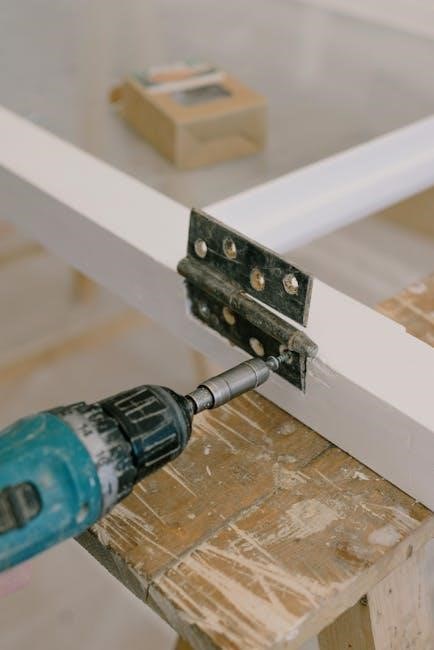HRV systems, or Heat Recovery Ventilation systems, are designed to improve indoor air quality and energy efficiency by recycling heat from exhaust air to fresh air, enhancing overall ventilation in homes and buildings․
1․1 What is an HRV System?
An HRV (Heat Recovery Ventilation) system is a mechanical ventilation technology designed to improve indoor air quality and energy efficiency․ It works by exchanging heat between the outgoing stale air and incoming fresh air, ensuring that the heat is retained within the building while providing a constant supply of fresh air․ This system is particularly useful in well-insulated homes, where natural ventilation may be insufficient․ HRV systems typically consist of a heat exchanger, fans, and ductwork, and they are controlled by specialized controllers that manage airflow and temperature settings․ By recovering heat from exhaust air, HRV systems help reduce energy consumption and maintain a comfortable indoor environment year-round․
1․2 Benefits of HRV Systems
HRV systems offer numerous benefits, including improved indoor air quality, enhanced energy efficiency, and reduced moisture issues․ By continuously exchanging stale air for fresh air, HRV systems help eliminate pollutants and odors, creating a healthier living environment․ They also recover heat from exhaust air, reducing the need for additional heating, which lowers energy consumption and costs․ Additionally, HRV systems prevent excess humidity, minimizing the risk of mold growth and structural damage․ They are particularly advantageous in well-insulated homes, where natural ventilation is limited․ Overall, HRV systems provide a balanced ventilation solution that supports both comfort and sustainability, making them a valuable addition to modern homes and buildings․
1․3 Types of HRV Systems
HRV systems are available in various configurations to suit different building types and ventilation needs․ The most common types include ducted systems, which integrate with existing HVAC systems for whole-house ventilation, and standalone units designed for specific areas․ There are also wall-mounted and ceiling-mounted options for flexibility in installation․ Additionally, some HRV systems feature smart controls, enabling users to adjust settings remotely or through integrated home automation systems․ Each type offers unique benefits, such as energy efficiency, space-saving designs, or advanced monitoring capabilities, ensuring there is an HRV solution for every home or building requirement․ This variety allows users to choose the most appropriate system based on their specific needs and preferences․

Installation and Setup
Proper installation and setup of HRV systems are crucial for optimal performance․ Always follow the manufacturer’s instructions and ensure the system is installed by a qualified professional․
2․1 Pre-Installation Checks
Before installing an HRV system, several checks are essential to ensure compatibility and safety․ Verify that the system matches your home’s ventilation needs and existing infrastructure․ Check local building codes and regulations to comply with legal requirements․ Inspect the unit and components for any damage or defects․ Ensure the electrical supply meets the system’s specifications, and confirm the ductwork layout aligns with the installation plan․ Consult the manufacturer’s manual for specific prerequisites․ Failure to perform these checks may result in improper installation, reduced efficiency, or potential safety hazards․
2․2 Step-by-Step Installation Guide
Start by preparing the site, ensuring all tools and components are ready․ Mount the HRV unit securely in a well-ventilated area, typically in a utility room or basement․ Connect the ductwork to the unit, ensuring proper sealing to prevent air leaks․ Install fresh air and exhaust vents, positioning them to maximize airflow and meet local building codes․ Connect electrical wiring according to the manufacturer’s instructions, ensuring polarity is correct to avoid electrical hazards․ Finally, test the system to confirm proper operation and adjust settings as needed․ Always follow the provided manual for specific installation details to ensure safety and efficiency․
2․3 Initial Setup and Configuration
After installation, power on the HRV system and follow the controller’s startup sequence․ Refer to the manual to set your preferred mode, such as continuous ventilation or boost mode․ Adjust timer settings and airflow rates according to your needs․ Ensure all sensors, like humidity or CO2 sensors, are calibrated and functioning properly․ Check local settings, such as temperature thresholds, to optimize performance․ Pair any smart features with your home network for remote control․ Finally, test the system by running a full cycle to ensure smooth operation․ Always consult the manual for specific configuration steps to guarantee safety and efficiency․

Operating the HRV System
Operate the HRV system using its controller, selecting modes like continuous ventilation or boost for specific needs․ Ensure energy efficiency by monitoring airflow and settings․
3․1 Basic Operation and Controls
The HRV system operates by drawing stale air out and introducing fresh air, using a heat recovery core to maintain energy efficiency․ Users can control the system via a wall-mounted controller or touch screen interface, selecting modes such as continuous ventilation or boost for increased airflow․ The system can be turned on or off manually or programmed to run automatically based on set schedules․ Adjusting settings like airflow speed or humidity levels ensures optimal performance․ Regular checks of filters and ducts are recommended to maintain efficiency․ Always follow the manufacturer’s guidelines for operation to ensure safety and effectiveness․ Proper use of controls helps maximize indoor air quality while minimizing energy consumption․
3․2 Using HRV Controllers
HRV controllers are essential for managing system operations, offering intuitive interfaces to adjust settings․ Most systems come with wall-mounted or touch-screen controllers, allowing users to select modes like continuous ventilation or boost․ The HRV Classic controller features a locking function to prevent unauthorized changes, while advanced models offer humidity sensors and timer functions․ Users can navigate through menus to adjust airflow speeds, set schedules, or enable smart features․ The LCD display provides real-time feedback on system status, humidity levels, and error codes․ Adjusting settings like backlight brightness ensures visibility, while advanced controllers integrate with smart home systems for remote control․ Always refer to the manual for specific instructions on your controller type․
3․3 Advanced Features and Settings

Advanced HRV systems offer enhanced functionality to optimize performance and user convenience․ Features like smart home integration via Wi-Fi allow remote control through apps, enabling users to adjust settings, monitor air quality, and receive notifications․ Some models include humidity sensors that automatically adjust ventilation rates to maintain ideal indoor conditions․ Timer functions and energy-saving modes further customize operation, reducing energy consumption․ Touch-screen controllers provide intuitive navigation for advanced settings, while voice command compatibility adds hands-free control․ Certain systems also offer customizable airflow speeds and filters to cater to specific needs․ Always consult your HRV manual to explore and configure these features effectively, ensuring optimal system performance and energy efficiency․

Maintenance and Troubleshooting
Regularly clean filters and inspect ducts to ensure optimal performance․ Troubleshoot common issues like insufficient ventilation or error codes by consulting the HRV manual for solutions․
4․1 Routine Maintenance Tasks
Regular maintenance is essential to ensure your HRV system operates efficiently․ Start by cleaning or replacing filters every 1-3 months, depending on usage․ Inspect ducts for blockages or leaks and clean them annually․ Check the heat recovery core for dust buildup and clean it as needed․ Ensure the outdoor unit is free from debris and protected from harsh weather․ Disconnect power before servicing to avoid electrical risks․ Also, inspect the controller settings to ensure proper operation․ Refer to your HRV manual for specific maintenance schedules and guidelines tailored to your system․ Regular upkeep helps maintain air quality, energy efficiency, and system longevity․
4․2 Common Issues and Solutions
Common issues with HRV systems include reduced airflow, excessive noise, or malfunctioning controls․ Reduced airflow often results from dirty filters or blocked ducts; cleaning or replacing filters and inspecting ducts typically resolves this․ Noise issues may stem from loose components or improper installation; tighten any loose parts and ensure the system is correctly mounted․ For control malfunctions, check connections and settings, and restart the system․ If issues persist, refer to the error codes in your HRV manual for troubleshooting guidance․ Addressing these problems promptly ensures optimal performance and prevents more severe complications․ Always follow safety precautions when servicing the unit to avoid electrical hazards․
4․3 Understanding Error Codes
HRV systems often display error codes to indicate specific issues․ These codes are essential for diagnosing and resolving problems efficiently․ Common codes include “E1” for sensor malfunctions and “E2” for ventilation imbalances․ Refer to your HRV manual for a detailed list of codes and their meanings․ For example, “E3” may indicate a faulty motor, while “E4” could signal a blockage in the ductwork․ Understanding these codes allows users to identify the root cause of an issue and take appropriate action, such as cleaning filters or checking electrical connections․ Always consult the manual for specific solutions, and contact a professional if the problem persists․ Regularly reviewing error codes ensures optimal system performance and prevents further complications․

Technical Specifications and Compatibility
HRV systems include heat exchangers, fans, and controls, ensuring compatibility with various HVAC setups․ They often meet ENERGY STAR standards for energy efficiency and performance․
5․1 System Components Overview
An HRV system typically includes a heat exchanger, ventilation fans, air filters, and a control unit․ The heat exchanger transfers heat from exhaust air to fresh air, while fans ensure proper airflow․ Filters remove contaminants, and controls regulate system operation․ These components work together to enhance indoor air quality and energy efficiency․
5․2 Compatibility with Other Systems
HRV systems are designed to integrate seamlessly with other home systems, such as central heating, cooling, and smart home technologies․ They can be paired with ducted systems, heat pumps, and air conditioning units to optimize performance․ Compatibility ensures efficient operation and enhanced comfort, allowing for comprehensive home automation and energy management․ Proper installation and configuration are key to maintaining compatibility and functionality․
5․3 Energy Efficiency and Ratings
HRV systems are highly energy-efficient, designed to minimize energy consumption while maintaining optimal indoor air quality․ They recover heat from exhaust air, reducing the need for additional heating, and often feature advanced sensors to optimize performance․ Many models are ENERGY STAR certified, ensuring they meet rigorous energy efficiency standards․ Ratings are typically based on factors like airflow capacity (CFM) and energy use (watts), with higher efficiency units offering lower operational costs․ Proper installation and maintenance are crucial to achieving the rated performance․ Energy-efficient HRV systems not only reduce energy bills but also contribute to a more sustainable and environmentally friendly home environment․

Accessories and Upgrades
Enhance your HRV system with accessories like filters, controllers, and ducting components․ Upgrades include smart home integrations, advanced sensors, and energy-efficient features for improved performance․
6․1 Available Accessories
HRV systems offer a range of accessories to enhance functionality and customization․ These include advanced controllers, such as touchscreen interfaces and smart home-compatible devices, allowing seamless system control․ Additional components like high-quality air filters, ducting kits, and vent covers ensure optimal performance and aesthetics․ Smart sensors can be integrated to monitor air quality and adjust ventilation automatically․ Accessories like remote access modules enable users to manage their HRV system from anywhere via Wi-Fi․ Optional upgrades, such as humidity sensors or heating elements, further tailor the system to specific needs․ All accessories are designed to integrate smoothly with existing HRV units, ensuring compatibility and ease of installation for a personalized ventilation solution․
6․2 Upgrading Your HRV System
Upgrading your HRV system can enhance performance, efficiency, and functionality․ Start by assessing your current system’s capabilities and identifying areas for improvement, such as adding smart home integration or advanced filtration․ Consider installing new components like energy-recovery cores, improved motors, or upgraded controllers for better control․ Ensure compatibility with your existing setup by consulting the manufacturer’s guidelines․ Professional installation is recommended for complex upgrades to maintain system integrity․ Regularly updating your system can improve indoor air quality, reduce energy costs, and extend the unit’s lifespan․ Always follow the manufacturer’s instructions for a seamless upgrade process and optimal results․
6․3 Integrating Smart Home Features
Integrating smart home features into your HRV system enhances convenience and efficiency․ Smart controllers allow remote operation via smartphones, enabling temperature adjustments and schedule settings․ Voice command compatibility with systems like Alexa or Google Assistant offers hands-free control․ Energy monitoring features provide insights into your system’s performance, optimizing energy usage․ Smart sensors detect air quality and automatically adjust ventilation, improving indoor conditions․ Ensure compatibility by checking manufacturer specifications and following installation guides․ Regular firmware updates maintain system security and functionality․ Integrating smart technology transforms your HRV system into a seamless part of your connected home, offering enhanced comfort and efficiency․

Warranties and Support
HRV systems come with manufacturer warranties, ensuring coverage for parts and labor․ Customer support options include phone assistance and online resources․ Service centers provide repair services, maintaining system efficiency․
7․1 Manufacturer Warranty Details
Manufacturer warranties for HRV systems vary by model but generally cover parts and labor for a specified period․ Most warranties last 5-10 years, depending on the system type․ Coverage typically includes defects in materials and workmanship but excludes normal wear and tear․ To maintain warranty validity, users must follow installation and maintenance guidelines outlined in the manual․ Registration may be required to activate the warranty․ Extended warranties or service plans may also be available for additional protection․ Always review the warranty terms provided with your HRV system to understand coverage limits and conditions․ Proper adherence ensures maximum benefit and system longevity․
7․2 Customer Support Options
HRV system manufacturers offer comprehensive customer support to ensure optimal performance and address user concerns․ Support options include telephone assistance, available Monday through Friday during business hours, and online resources accessible 24/7․ Users can visit the official website for detailed FAQs, troubleshooting guides, and downloadable manuals․ Live chat support is also available for immediate inquiries․ Additionally, local service centers provide in-person assistance for repairs and maintenance․ For urgent issues, customers can contact the dedicated support team at 0800 HRV 123․ Manufacturers often include a support section in the user manual, outlining contact details and steps for resolving common problems․ This ensures users can quickly access help when needed, minimizing downtime and maximizing system efficiency․
7․4 Service Centers and Repair
Authorized HRV service centers provide professional repair and maintenance services to ensure optimal system performance․ These centers are equipped with trained technicians and genuine parts to handle all types of repairs, from minor issues to complex overhauls․ Customers can locate their nearest service center through the manufacturer’s website or by contacting customer support․ Repair services include diagnosing faults, replacing worn-out components, and performing routine maintenance․ Many centers also offer on-site visits for convenience․ To schedule a repair, users can call the dedicated support hotline or submit a service request online․ Manufacturer warranties typically cover repairs for defective parts, ensuring cost-effective solutions for system issues․ Regular maintenance by certified technicians is recommended to maintain warranty validity and system efficiency․
HRV systems are a valuable addition to any home, improving air quality and energy efficiency․ Regular maintenance and adherence to manufacturer guidelines ensure optimal performance and longevity․
8․1 Summary of Key Points
8․2 Best Practices for Users
To ensure optimal performance and longevity of your HRV system, follow these best practices: Always refer to the manual for specific instructions․ Regularly clean filters and vents to maintain airflow efficiency․ Schedule annual professional maintenance to inspect and service core components․ Adjust settings according to seasonal changes to optimize heating and cooling recovery․ Use smart controllers to automate operations and monitor system performance․ Address error codes promptly to prevent system malfunctions․ Keep the system free from dust and moisture to avoid damage․ Ensure proper ventilation in areas like bathrooms and kitchens to maximize efficiency․ By adhering to these practices, users can enhance comfort, reduce energy costs, and extend the lifespan of their HRV system․
8․3 Future of HRV Technology
The future of HRV technology promises significant advancements, with a focus on smart home integration, enhanced energy efficiency, and improved health monitoring․ Next-generation systems will likely feature advanced sensors and AI-driven controls to optimize ventilation based on real-time indoor air quality and occupancy patterns․ Integration with wearable devices could allow HRV systems to adjust settings based on individual health metrics, such as heart rate variability․ Additionally, compact and quieter designs are expected to cater to urban living spaces, while eco-friendly materials and energy-saving modes will align with global sustainability goals․ These innovations will make HRV systems more intuitive, efficient, and adaptable to future living needs․


